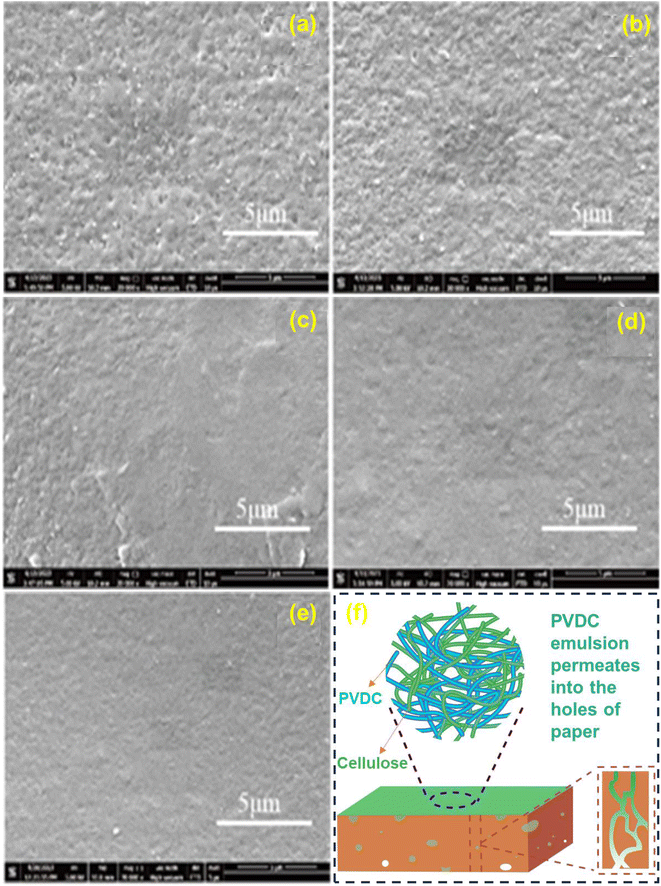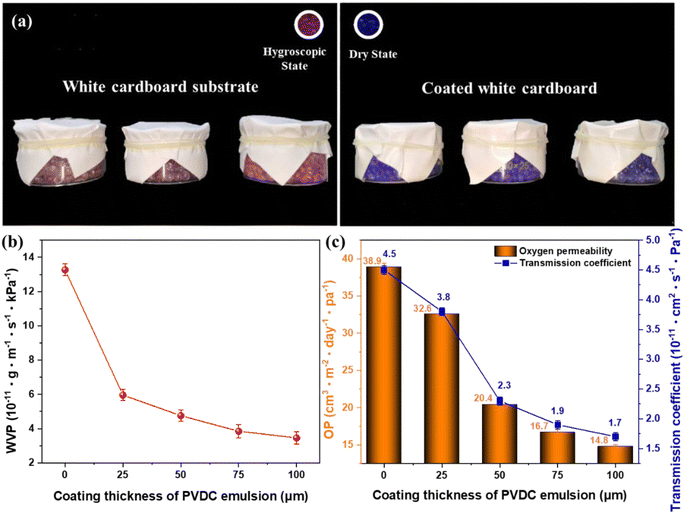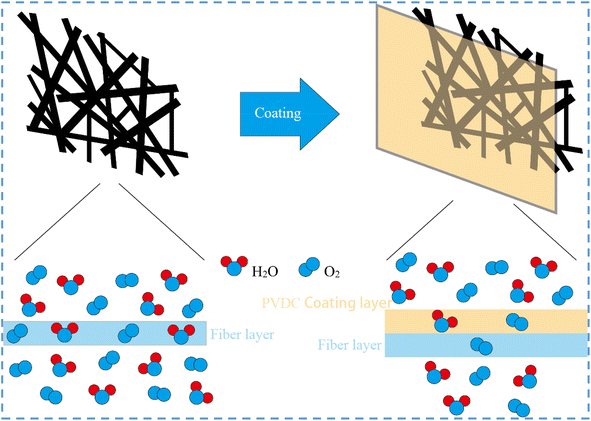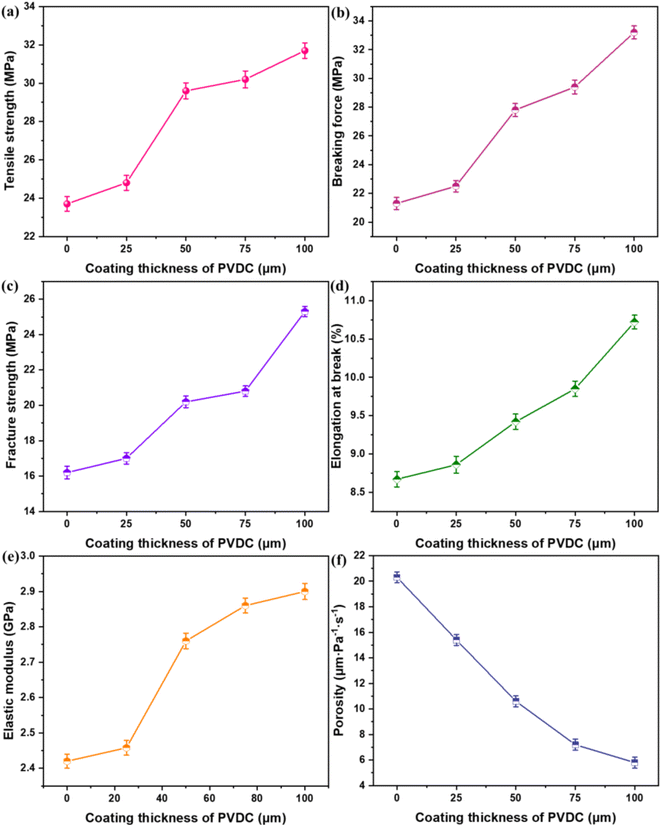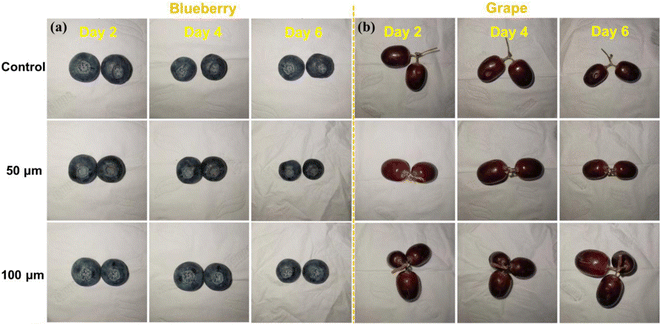 Open Access Article
Open Access ArticleDevelopment of high barrier-coated white cardboard for fruit preservation†
Zheng Cheng *abc,
Jialin Liae,
Miao Suad,
Naiyu Xiao*abd,
Le Zhong*ab,
Xueqin Zhangabc,
Meixian Liuab,
Qifeng Chenc and
Jinxian Zhouab
*abc,
Jialin Liae,
Miao Suad,
Naiyu Xiao*abd,
Le Zhong*ab,
Xueqin Zhangabc,
Meixian Liuab,
Qifeng Chenc and
Jinxian Zhouab
aCollege of Light Industry and Food Technology, Academy of Contemporary Agricultural Engineering Innovations, Zhongkai University of Agriculture and Engineering, Guangzhou, CN 510225, China. E-mail: chengzheng@zhku.edu.cn; 1308865979@qq.com; 786583136@qq.com
bGuangdong Provincial Key Laboratory of Lingnan Specialty Food Science and Technology, Zhongkai University of Agriculture and Engineering, Guangzhou, CN 510225, China
cState Key Laboratory of Pulp and Paper Engineering, South China University of Technology, Guangzhou, CN 510640, China
dResearch Center of Chinese Medicinal Resource Science and Engineering, Guangzhou University of Chinese Medicine, Guangzhou 510006, China
eEngineering Research Institute, Jiangxi University of Science and Technology, Ganzhou 341000, China
First published on 27th June 2024
Abstract
Environment-friendly and biodegradable packaging materials have attracted widespread attention. Development of green solutions to extend the fruit shelf life and address fruit preservation thus has a far-reaching impact. In this study, high-barrier white cardboard (WC) was prepared by a facile coating method. Compared with the WC substrate, the WVP value of the polyvinylidene chloride (PVDC) emulsion-coated WC (3.46 × 10−11 g m m−2 s−1 kPa−1) decreased 73.8% and the OP value (14.8 cm3 m−2 day−1·Pa−1) decreased 61.9%. In addition, the mechanical properties of the PVDC emulsion-coated WC increased significantly. The weight loss rate and decay rate of the stored fruits packaged with PVDC emulsion-coated WC decreased by about 5%. The high barrier PVDC emulsion-coated WC with excellent mechanical properties, good barrier effect, and preservation function was successfully prepared. Benefitting from these investigated characteristics, the obtained coated WC can be used to package fruits to reduce water loss and delay ripening, and thus extend their shelf life, exhibiting a favorable effect on blueberry and grape storage. Overall, the fabricated eco-friendly coated white cardboard has shown great potential for biodegradable packaging applications. We believe the current work presents an approach to address perishable fruit preservation and provide a supplement alternative.
Introduction
In recent years, with the growing popularity of the digital economy to help the sale of agricultural products, rural revitalization and common prosperity have been promoted. Against this backdrop, the sales of food products such as fresh produce are increasing, leading to the increased use of packaging materials.1 At present, China owns the world's largest packaging market, while the ecological burden caused by packaging waste to the environment has intensified. Furthermore, with the introduction of national mandatory environmental protection policies and the dual carbon strategy, enterprises need to practice the goal of sustainable development in the packaging field. Therefore, an increasing number of enterprises has been using paper-based materials as the green packaging material choice. Compared with the most commonly used petroleum-based plastic packaging for food products in the past, paper-based packaging has the characteristics of easy degradation, green environmental protection, and other requirements of the times.2–4 However, the strength and barrier performance of paper-based packaging are not as good as those of petroleum-based plastic packaging, which limit the large-scale application of paper-based packaging in food transportation and preservation.5,6 Therefore, the multi-layer composite paper packaging derived from a variety of materials has been developed to improve properties of paper-based packaging materials.7,8 In addition, the paper-based packaging has truly become an excellent choice of green packaging in the new era.The application history of packaging materials can be traced back 5000–7000 years, and paper bags were used to package tea in the Tang Dynasty. Since then, the paper-based packaging materials were widely used in the fields of books, pens, ink, and inkstone.9–11 After a long time of development and evolution, glass, metal, plastic, and paper have become the four major packaging materials in modern times.12 Among the four major packaging materials, glass and metal have the shortcomings of large total mass, fragility, easy deformation, and high energy consumption. Plastic packaging causes environmental pollution problems, and the current industry trend is inconsistent. Paper-based packaging materials with the advantages of a wide range of sources, recyclability, renewability, degradability, and other beneficial characteristics in the life cycle assessment are recognized as the most promising sustainable green packaging materials. In the past decade, the paper packaging industry has maintained a continuous growth trend, and related research and development have been rapid.13,14 However, as the basic component of paper-based packaging materials, plant-based cellulose fibers contain a large amount of hydrophilic hydroxyl groups. The porous three-dimensional structure of the paper-based material itself will affect the barrier performance of the packaging material15 (water barrier, oxygen barrier, moisture-proof, etc.). The mechanical indicators of the paper-based packaging material would decrease after moisture absorption, which would weaken the protective performance of the packaging.16,17 Therefore, the improvement of the mechanical and barrier properties of paper-based packaging materials through surface sizing in the papermaking process has become an important direction.18
In the packaging field, food packaging is undoubtedly the most common application scenario of paper-based packaging materials. In order to further reduce the use of petroleum-based polymers and promote the replacement of plastic with paper, experts and scholars have done extensive research and exploration on how to achieve the highest possible proportion of paper-based packaging materials under the premise of saving energy.19 They skillfully use paper-based materials with good machining characteristics and good compatibility with waterborne materials such as inks and coatings,20 frozen product packaging,21 paper straws,22 and kaolin-coated paper.23 The latest research direction is the application of degradable materials such as polyesters,24 polysaccharides,25 proteins,26 and other materials in the coating of paper-based materials. The series of innovative achievements and applications will give paper-based materials a wider application prospect and help the development of “green packaging”. The general definition of composite materials implies that they must be composed of two or more materials with different chemical and physical properties, and composite materials can be divided into fiber-reinforced composites and laminated composites according to the morphology of the reinforced phase. Fiber-reinforced composites refer to hydrophobic modification of cellulose by carboxylation,27 crosslinking,28 esterification,29 and other reactions by blending with polymers.3 The laminated composite material refers to the paper as the substrate, and then the paper was treated with other materials (metal foils and plastic films) through the composite technology treatment to form a multi-functional composite packaging material. The resulting composite material combines the advantages of various components, acting as an ideal packaging material choice.30 Various coatings were applied to improve the paper barrier performance, among which the water-based coating has a good development prospect, which uses water instead of organic solvents as the solvent or dispersion medium, saving a lot of resources and meeting the requirements of green environmental protection, energy conservation, and emission reduction.20,31 The development of coatings using renewable and degradable resources such as chitosan32 and starch33 as raw materials has become a research hotspot in recent years. Gradually, they have been applied in food preservation,34 antibacterial materials,6 packaging, and other fields.
In this work, we prepared high-barrier white cardboard by coating with polyvinylidene chloride (PVDC) emulsion. This work attempted to design eco-friendly and biodegradable packaging paper for extending the shelf life of fruits. The coated WC was further characterized in terms of morphological structure, barrier performance, and mechanical properties. The enhancement mechanism of barrier performance of PVDC emulsion-coated WC was also discussed and explored. Finally, the preservation ability was also investigated to assess its practicability for use in blueberry and grape packaging. The environmentally friendly coated WC has important potentiality as a biodegradable and renewable fruit packaging material. Thus, the work is of great importance to those researchers in the field of barrier paper-based packaging materials.
Materials and methods
Materials
Color-changing silicone (particle size specification: 2.0–5.0 mm) was received from Qingdao Mack Silica Gel Desiccant Co., Ltd. Vaseline (Chinese Pharmacopoeia 90th edition) was furnished by Genie Medical Equipment Factory Co., Ltd. PVDC emulsion was purchased from Dongguan He Shengyuan New Material Technology Co., Ltd. WC (quantification: 120 g m−2; thickness: 140 μm) was provided by Yiwu Qiaoguan Paper Products Co., Ltd. Paint A (main components include oxidized cellulose nanofibrils, chitosan, and starch) and paint B (main components include polyvinyl alcohol and quaternized chitosan) were lab-made coating. All other chemicals were of AR grade and used without further purification.Preparation of coated WC with different coatings
A 210 mm × 297 mm WC base paper sheet was used as the substrate, and paint A, paint B, and PVDC emulsion were coated on one side using an automatic coating machine (AFA-IV, Dongguan Dalai Instrument Co., Ltd) at a coating speed of 3.0 cm s−1. The paper was dried in an electric vacuum-drying oven (DZF-6050A, Tianjin Hongnuo Instrument Co., Ltd) at 90 °C for 5 min and then removed and allowed to cool to room temperature before storage in a ziplock bag.Preparation of coated WC with different drying methods
A 210 mm × 297 mm WC base paper sheet was used as the substrate, which was coated with a PVDC emulsion to the same coating thickness. The coated papers were separately dried in three different ways: ① natural air drying, ② drying at 90 °C for 5 min in an electric vacuum-drying oven (DZF-6050A, Tianjin Hongnuo Instrument Co., Ltd) followed by curing treatment by putting them into a digital electric heating blast drying oven (TOM-150E, Shanghai Tomos Scientific Instrument Co., Ltd) at 40 °C for 48 h, and ③ drying at 150 °C for 1 min in an electric vacuum-drying oven. Finally, the coated WC papers were separately put into a ziplock bag after cooling to room temperature.Thickness test
The coated WC was cut into several 100 mm × 100 mm paper patterns, and the flat position of the paper pattern surface was selected. The thickness of the paper pattern was measured by the five-point measurement method using a GB-3 thickness gauge with an accuracy of 0.001 mm (GB-3, Shenzhen Hamp Testing Instrument Co., Ltd), and the average of all the data was taken.SEM analysis
A number of WC samples coated with paint A, paint B, and PVDC emulsion were taken respectively, and the WC sample surface was fixed on the sample stage. Then the WC sample was conductive after gold spraying on the surface, and the surface morphology of the WC paper pattern was photographed using a scanning electron microscope (Quanta 250, FEI Corporation) at an accelerating voltage of 5 kV.Tensile properties
The mechanical property test of WC paper was carried out in accordance with GB453. The WC sample was cut into a long strip specimen of 100 mm length and 10 mm width, and the specimen was clamped between the fixtures of the GBH-1 electronic universal material testing machine (GBH-1, Guangzhou Biaoji Packaging Equipment Co., Ltd) to ensure that the specimen was clamped correctly and that the specimen was vertical. The clamp spacing was 25 mm, and the load was 100 N. The tensile speed was set as 100 mm min−1. The tensile strength of high-barrier coated WC was determined. Each group of samples were tested three times in parallel, and then the results were averaged. Bendtsen porosity was determined using an air permeance tester (L&W166, Sweden) based on ISO 5636-3.Water vapor permeability (WVP)
Several weighing flasks of the same size were filled with 15 g of absolute dry color-changing silicone, and the flask mouth was covered with coated WC with different thicknesses of PVDC emulsion (the coated face of the WC was facing towards the outside the flask). The flasks were firmly tied with a rubber band. Then the weighing flasks were weighed one by one, and the initial mass was recorded as m0. The weighing flasks were placed in a dryer with water underneath and separated by a separator in the middle. The weighing flasks were on the separator. Petroleum jelly was applied around the edge of the dryer lid for a circle and covered it firmly to artificially create a high humidity environment. The mass of each weighing flask was accurately weighed every 24 h and the data were recorded for 7 days. Each sample was measured three times in parallel, and the results were averaged. The relevant formula used for calculation is as follows:
 | (1) |
 | (2) |
Oxygen permeability (OP)
The oxygen permeability performance test was performed in accordance with the GB/T1038-2000 test principle using paper samples to separate the low-pressure cavity and high-pressure cavity. A vacuum pump was used to vacuum the low-pressure cavity, and then the high-pressure cavity was filled with 105 Pa pure oxygen. The pressure change value Δp of the low-pressure cavity was measured, and the oxygen transmission of the sample can be determined. The transmission coefficient of the gas can be obtained after calculation. Each sample was measured three times in parallel, and the results were averaged.The oxygen transmission was calculated as follows:
 | (3) |
The oxygen transmission was calculated as follows:
 | (4) |
Weight loss rate
The initial mass of each bag of fruits was accurately measured and recorded as m0. The fruits in each paper bag were took out every 2 days and weighed accurately, and the values were recorded as m2, m4, and m6. Each sample was measured three times in parallel, and the results were averaged. The weight loss rate was calculated as follows:
 | (5) |
Rot rate
Fruits with damaged or softened epidermis were considered rotten fruits. Each sample was measured three times in parallel, and the results were averaged. The rot rate of fruits was calculated as follows:
 | (6) |
Sensory evaluation
According to the sensory evaluation criteria presented in Table 1, the fruits of the preservation and storage experiment were scored by the sensory evaluation of four indicators, namely, color, dryness, decay area, and flavor, and the total sensory scores were added together.| Standard | Level 1 (excellent) | Level 2 (good) | Level 3 (middle) | Level 4 (difference) |
|---|---|---|---|---|
| Fraction | ||||
| Color (20) | 18–20 | 14–18 | 10–14 | <10 |
| Dry shrinkage (30) | 27–30 | 21–27 | 15–21 | <15 |
| Decay area (30) | 27–30 | 21–27 | 15–21 | <15 |
| Flavor (20) | 18–20 | 14–18 | 10–14 | <10 |
Statistical analysis
Each experiment was performed in triplicate, and the results were expressed as mean ± standard deviation (SD). Statistical analysis was performed using the GraphPad 9 statistical software (GraphPad Software, San Diego, USA). We conducted one-way ANOVA analysis followed by Dunnett's method to determine the significant differences (P < 0.05) between the experiment data.Results and discussion
One of the factors affecting the barrier and mechanical properties of coated paper is the dispersion of coating on the surface. SEM is an important tool to understand the morphological and structural characteristics of cellulosic fiber before and after the coating process. Therefore, to monitor the dispersion of coating on the white cardboard surface, the morphologies of WC coated with different paints were characterized by SEM, as shown in Fig. 1, which displays the smooth surface of fibers and a large number of big holes between fibers on the WC substrate (Fig. 1a). Compared with the SEM images of the WC substrate, it could be observed that after coating with paint A (Fig. 1b), the fiber gaps of the WC were filled by paint A, forming a tighter structure, but the uncovered paper fibers and a large number of holes could still be observed on the surface. After coating with paint B (Fig. 1c), the coating formed a film on the surface of the WC, so that the coated WC had a denser physical structure. However, it can be observed that there were protrusions and more fine holes on the surface of the coating, and there was a lack of flatness and continuity of the coating. These phenomena suggested that paint A and paint B tend to entangle and aggregate during film formation. Compared with paint A and paint B, after the WC was coated with the PVDC emulsion (Fig. 1d), except for the unevenness of some surface areas, the overall performance of the composite paper was the best. It was verified that the addition of the PVDC emulsion could form multiple intramolecular interactions such as hydrogen bonds with cellulose fibers and thus facilitate the formation of more uniform films. Altogether, the surface of the PVDC emulsion-coated WC was flat and continuous, which could give the paper-based material better barrier performance to the greatest extent. More importantly, the increased smoothness and more compact surface of WC were beneficial to improve the barrier properties of packaging paper, which was good for the practical application in high-performance packaging materials for food preservation.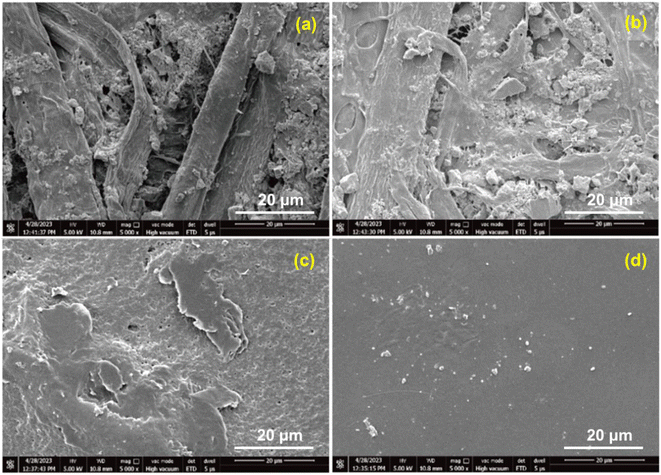 | ||
| Fig. 1 SEM images of WC coated with different paints: (a) WC substrate; (b) paint A; (c) paint B; and (d) PVDC emulsion. | ||
The coating method has a great influence on the dispersion of coating on the substrate. In order to further explore the distribution of the PVDC emulsion on coated WC, the SEM images of PVDC emulsion-coated WC with different drying methods and different thickness are shown in Fig. 2. It can be observed that there were many depressions and holes on the surface of the coated WC formed by natural drying at room temperature (Fig. 2a), and many white bubble-like protrusions appeared on the surface of the coated WC. The overall flatness and continuity of the coated WC were poor, which affected the barrier performance of the coated WC. The surface of the coated WC shown in Fig. 2b had depressions and bubble-like bulges similar to those shown in Fig. 2a, which may be caused by extreme drying temperatures and uneven temperatures on the paper surface. As shown in Fig. 2c, the surface of the coated WC after drying and curing at 90 °C was relatively flat, and only a few protrusions can be observed on the surface. The degree of unevenness on the surface of the coated WC was smaller, and the overall apparent quality was the best among the other two drying methods, providing support for the enhancement of the composite paper's barrier properties. The coating thickness was achieved by controlling the amount of coating via the coating machine. From Fig. 2c–e, it can be observed that the surface topography of the coated WC became flatter as the coating thickness increased. At low coating thicknesses, the coating cannot fill all the voids on the surface of the WC substrate and form a flat and dense coating film. With the increase in coating thickness, the coverage and uniformity of the coating film on the WC substrate were significantly improved due to the homogeneous dispersion of the PVDC emulsion in the cellulose matrix. There were no obvious blocky protrusions on the surface of the coated WC, and the number and degree of depressions were reduced, which could effectively reduce gas and water vapor molecule permeation through the film. By continuously improving the coating thickness of the PVDC emulsion, the depression degree and area of the surface of the coating film layer were further reduced, and the good flatness and uniformity of the coating film made it difficult for gas and water vapor molecules to pass through and achieved good barrier performance. The physical bond between the PVDC emulsion and WC is shown in Fig. 2f. The PVDC emulsion permeated into holes on the WC and could form good bonds with the cellulose fiber, and the adhesive strength between the fiber and the fiber in the WC substrate was further expanded. Benefitting from these investigated characteristics, the coated WC was able to exhibit a favorable mechanical strength. Besides, the composite-coated WC with a dense structure and flat surface was beneficial in achieving excellent barrier properties.
The water resistance represents the stability and water absorption capacity of packaging materials in long-term storage, and good water resistance is advantageous in the packaging for most products, especially for food storage which needs adequate packaging integrity. The intuitive dampness effect between the WC substrate and PVDC emulsion-coated WC is shown in Fig. 3a. It can be observed that the dry silica gel changed color quickly in the high humidity environment, while the color change of PVDC emulsion-coated WC was not obvious. On the whole, the barrier performance of PVDC emulsion-coated WC was better than that of paint A- or paint B-coated WC with the same coating thickness. Unlike the change curve of oxygen permeability, the water vapor transmittance of PVDC emulsion-coated WC decreased significantly compared to the WC substrate (Fig. 3b). With a coating thickness of 25 μm, the WVP value of PVDC emulsion-coated WC (5.81 × 10−11 g m m−2 s−1 kPa−1) decreased almost 56.3% with reference to the WC substrate (1.32 × 10−10 g m m−2 s−1 kPa−1). While the paint A-coated WC had a WVP value of 1.01 × 10−8 g m m−2 s−1 kPa−1, paint B-coated WC had a WVP value of 8.46 × 10−9 g m m−2 s−1 kPa−1 with the same coating thickness (Fig. S1a†). It could be also found that paint B-coated WC exhibited better water vapor barrier capability than that of paint A-coated WC. The WVP value of PVDC emulsion-coated WC reached 3.46 × 10−11 g m m−2 s−1 kPa−1 with a coating thickness of 100 μm, which decreased about 73.8% as compared to the WC substrate. The possible reason is that the PVDC emulsion had better barrier properties when coated on the surface of WC substrate, which covered the fiber structure of the WC substrate to a certain extent. The PVDC emulsion coating layer prevented the direct contact between water molecules and the fibers with hydrophilic properties in the WC substrate, and inhibited the occurrence of capillary phenomenon. With the increase in coating thickness, the water vapor transmittance of PVDC emulsion-coated WC gradually decreased, but the reduction range gradually flattened. Generally speaking, oxygen diffusion and migration within packaging materials should be restricted because a humid atmosphere in the presence of oxygen favors microbial growth and gradually spoils the quality of the food inside. The oxygen permeability of PVDC emulsion-coated WC (32.6 cm3 m−2 day−1·Pa−1) decreased compared with the WC substrate (38.9 cm3 m−2 day−1·Pa−1) with a coating thickness of 25 μm, as shown in Fig. 3c. The OP value of the PVDC emulsion-coated WC could reach 14.8 cm3 m−2 day−1·Pa−1 with a coating thickness of 100 μm. The PVDC emulsion-coated WC possessed a lower OP value than those of both paint A-coated WC and paint B-coated WC (Fig. S1b†). Unlike water vapor permeability, paint A-coated WC exhibited better oxygen barrier capability than that of paint B-coated WC. With the increase in coating thickness, the oxygen permeability of PVDC emulsion-coated WC gradually decreased, but the reduction range gradually flattened. The largest reduction occurred between 25 μm and 50 μm, up to 40%, after which the oxygen permeability decreased by only 17% and 10%, although the gradient of the coating thickness was still increasing. The possible reason was that at a lower coating thickness of 25 μm, the PVDC emulsion failed to penetrate completely and covered the WC substrate, and could not form a continuous and dense coating film. As the coating thickness increased to 50 μm, the PVDC emulsion successfully formed a continuous dense coating film on the surface of the WC substrate, which could prevent the diffusion of oxygen molecules in the coated WC and improve the barrier performance of the paper-based composite material. Since then, although the coating thickness continued to increase, the properties of the coating itself, such as the proportion of components and the free volume fraction,35 have not changed, so the performance improvement cannot be significantly obtained.
Water vapor permeability and oxygen permeability are the vital properties for the packaging paper in food preservation. The schematic diagram of water and oxygen molecules passing through the coated white cardboard is exhibited in Fig. 4. From a microscopic perspective, the surface of the WC was a network structure interwoven by countless fibers and full of pores. Hence, microscopic particles such as water molecules and oxygen molecules can easily pass through the WC, resulting in poor barrier properties of the WC. When the surface of the WC was coated with the barrier coating, a complete and dense “protective layer” can be built for the fiber network structure, which could effectively prevent the above-mentioned microscopic particles from direct contact with the cellulose fiber. As shown in Fig. S2,† PVDC is a polymer with a linear polymeric chain structure connected end to end. Moreover, as for PVDC, due to its strong intermolecular agglutination force and high degree of crystallization, chlorine atoms in PVDC molecules were hydrophobic and did not form hydrogen bonds. In addition, oxygen and water molecules were difficult to move into PVDC molecules, which indicated that the PVDC molecules had excellent oxygen resistance and moisture resistance, and their oxygen resistance was not affected by ambient humidity. Furthermore, hydrophobic PVDC lengthened the diffusion path of water and oxygen molecules, and thus prevented the water vapor and oxygen permeation. Only a small amount of water and oxygen molecules could permeate the coated WC, resulting in a lower WVP and OP value. Altogether, these structure and characteristics could prevent the water molecule and oxygen molecule diffusion through the coated WC, thereby achieving the purpose of improving the barrier performance. Thus, the coated WC tended to impede the diffusion of water vapor and oxygen molecules into the paper-based material interior and hence meet the requirements of the special packaging applications.36 The fabrication process by adjusting the PVDC coating thickness enabled us to achieve the barrier performance and to meet the requirements for agricultural produce storage.
The mechanical properties of the coated white cardboard are important factors related to its load-bearing and impact resistance, which determine its application scenarios and development direction. The mechanical properties of coated WC with different coatings are summarized in Table 2. As expected, the overall mechanical index of WC coated with different coatings was significantly improved compared with the WC substrate. It can be explained by the fact that the coating could fill the gap of paper fibers and decrease the area of pores in WC, especially the coatings that aggregated together and formed the network, which led to a decrease in porosity and an increase in smoothness. The more compact surface of coated WC is beneficial to improve the mechanical properties. Under the same thickness, compared with paint A- and paint B-coated WC, PVDC emulsion-coated WC was slightly weaker in terms of elongation at break, with a value of 9.41%. Inversely, the PVDC emulsion-coated WC showed the best performance in the four indicators of breaking force (27.82 N), breaking strength (19.87 MPa), tensile strength (29.93 MPa), and elastic modulus (2826.98 MPa). In addition, the three indicators, namely, fracture force, breaking strength, and elastic modulus of PVDC emulsion-coated WC were more than 12.5% higher than those of the other two coatings of WC. Notably, the increase in breaking force and breaking strength was 84% compared with the WC substrate as a reference. This may be because PVDC itself had the characteristics of high toughness,37,38 so that the mechanical properties of PVDC emulsion-coated WC were also improved compared with the WC substrate. It is well accepted that the low mechanical strength is one of the main obstructions to the development of paper-based materials in packaging applications. Thus, the good mechanical strength of PVDC emulsion-coated WC was conducive to the packaging material for fruit preservation.
| Sample | Breaking force (N) | Strength at break (MPa) | Tensile strength (MPa) | Elongation at break (%) | Elastic modulus (MPa) |
|---|---|---|---|---|---|
| White cardboard | 15.06 ± 0.23 | 10.76 ± 0.06 | 25.50 ± 0.31 | 8.99 ± 0.36 | 2476.46 ± 1.05 |
| Paint A coated paper | 23.45 ± 0.31 | 16.75 ± 0.12 | 27.63 ± 0.23 | 10.66 ± 0.08 | 2576.79 ± 0.96 |
| Paint B coated paper | 23.39 ± 0.35 | 16.71 ± 0.08 | 28.52 ± 0.09 | 9.54 ± 0.17 | 2510.50 ± 0.83 |
| PVDC coated paper | 27.82 ± 0.12 | 19.87 ± 0.07 | 29.93 ± 0.45 | 9.41 ± 0.24 | 2826.98 ± 0.72 |
The excellent mechanical properties are necessary for these packaging materials to maintain mechanical integrity during handling and transportation. As presented in Table 3, the relevant mechanical properties of PVDC emulsion-coated WC prepared by the three drying methods were improved compared with the WC substrate, while the relative improvement of PVDC emulsion-coated WC under the condition of natural air drying at room temperature was not obvious. In addition, even the indicator of elastic modulus decreased from 2476.46 MPa to 2307.42 MPa. The reason may be that the copolymer particles in the PVDC emulsion were not condensed into a continuous and dense whole at a lower drying temperature, and the low crystallization of molecules at room temperature led to the failure in achieving the ideal crystallinity. The intermolecular force was weak, resulting in little changes in tensile strength and other indicators. The mechanical properties of PVDC emulsion-coated WC after a certain temperature and time curing treatment (at 90 °C for 5 min drying and then at 40 °C for 48 h curing treatment) were the best among the two other drying methods. Under these dry conditions, the PVDC emulsion-coated WC revealed the highest breaking force, breaking strength, tensile strength, and elastic modulus. The reason may be that the curing process allowed the PVDC emulsion coating to fully crystallize, which could achieve a high degree of crystallinity and give the coated WC good mechanical properties. With 150 °C as the drying temperature, although it can fully dry and achieve a more ideal molecular crystallization effect, the excessive drying temperature made the WC lose water rapidly, and the moisture was too low to increase the rigidity of the paper and the material became brittle. Thus, the ability to slip between fibers and disperse stress decreased to reduce the flexibility of the coated WC.39 Therefore, the mechanical properties of the PVDC emulsion-coated WC could be affected by different preparation routes.
| Sample | Breaking force (N) | Strength at break (MPa) | Tensile strength (MPa) | Elongation at break (%) | Elastic modulus (MPa) |
|---|---|---|---|---|---|
| White cardboard | 15.06 ± 0.12 | 10.76 ± 0.08 | 25.50 ± 0.32 | 8.99 ± 0.16 | 2476.46 ± 0.56 |
| Air dry naturally | 22.00 ± 0.34 | 13.75 ± 0.05 | 27.54 ± 0.26 | 10.66 ± 0.25 | 2307.42 ± 0.72 |
| Drying at 90 °C + 40 °C curing for 48 h | 27.82 ± 0.28 | 19.87 ± 0.13 | 29.93 ± 0.15 | 9.41 ± 0.07 | 2826.98 ± 0.38 |
| Dry at 150 °C | 21.71 ± 0.46 | 14.47 ± 0.09 | 28.83 ± 0.07 | 10.39 ± 0.08 | 2467.46 ± 0.42 |
As depicted in Fig. 5a–e, with the increase in the coating thickness of PVDC emulsion, the mechanical properties of PVDC emulsion-coated WC gradually improved. However, at a lower coating thickness (25 μm), the tensile strength, elongation at break, elastic modulus, and other indicators of PVDC emulsion-coated WC were not significantly improved compared with the WC substrate, which may be due to the low coating thickness resulting in the emulsion not completely penetrated into the WC substrate to form a continuous and tightly structured coating film. With the further increase in coating thickness, the mechanical properties of PVDC emulsion-coated WC with a coating thickness of 50 μm were better than those of 25 μm. Its fracture force, tensile strength, and elastic modulus were increased by 23%, 21%, and 14%, respectively. When the coating thickness was greater than 50 μm, the breaking strength of PVDC emulsion-coated WC can still be increased by more than 25%, and the breaking force can be increased by 14%. Porosity is a parameter that reflects the air and water molecule permeability, as shown in Fig. 5f. The porosity decreased with the increase in coating thickness, which was due to the fact that the PVDC emulsion filled the gap of fibers and decreased the area of pores in the WC substrate. The difference in other indicators was very small, so in terms of the mechanical properties of PVDC emulsion-coated WC, the coating thickness of 50 μm was optimal for energy consumption.
The weight loss rate is usually closely related to the freshness of the fruit and is an important indicator to judge whether the fruit is fresh. Because the fruit still undergoes transpiration and respiration after picking, causing the loss of water and dry matter,40 resulting in an increase in weight loss rate. It can be seen in Fig. 6a and b that in the storage process of 6 days, the weight loss of the two fruits with PVDC emulsion-coated WC packaging was less than that of the fruit packaged in the WC substrate. After the whole storage process, the weight loss rate of the two fruits with PVDC emulsion-coated WC packaging was reduced by 4.8% and 5.4% compared with the blank control group, respectively. The results indicated that PVDC emulsion-coated WC packaging can reduce the water loss of the fruit to a certain extent by establishing a barrier outside the fruit. In addition, the gas barrier effect of the PVDC emulsion-coated WC packaging weakened the respiration of the fruit and reduced the loss of substances inside the fruit. Blueberry and grape are highly susceptible to lose water owing to their respiration and transpiration. In this study, the rot rate and weight loss rate of blueberry and grape were tracked over storage for six days, and the results are revealed in Fig. 6c and d. Compared with the blank control group (fruits packaged in uncoated WC), the rot rate of the two fruits packaged with PVDC emulsion-coated WC was reduced by 4.2% and 2.5%, respectively. This proved that the PVDC emulsion-coated WC packaging effectively blocked the direct contact between the oxygen outside and the fruits in the package, and weakened the respiration of the fruits. It could reduce the water produced by the fruit due to respiration and keep the storage environment of the fruit dry, so as to achieve the purpose of inhibiting the growth of microorganisms and reducing the fruit spoilage rate.
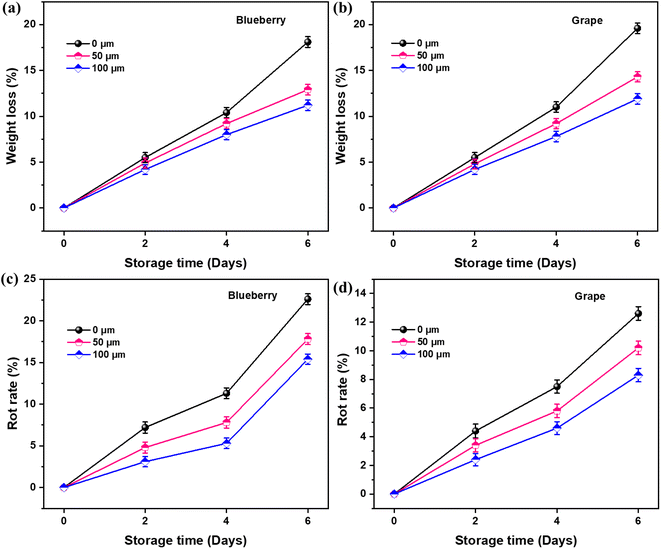 | ||
| Fig. 6 Weight loss of (a) blueberry and (b) grape during storage in PVDC emulsion-coated WC packaging. Rot rate of (c) blueberry and (d) grape during storage in PVDC emulsion-coated WC packaging. | ||
To evaluate the capability of the PVDC emulsion-coated WC to maximize the shelf-life of fresh fruits, the appearance change of blueberry and grape during 6 days of storage was examined (Fig. 7). From Fig. 7a, we can see that the blueberry fruits of the blank control group (packaged in uncoated WC) recorded by sampling and recording appear wrinkled after 4 days of storage at room temperature, and the shrinkage was more obvious at the end of storage, while the blueberries packaged in PVDC emulsion-coated WC with lower coating thickness (50 μm) only showed epidermal shrinkage after 6 days of storage. Blueberries packaged in PVDC emulsion-coated WC with a high coating thickness (100 μm) exhibited only slight shrinkage throughout storage and were best stored. As displayed in Fig. 7b, the situation of the grape storage group was similar to that of the blueberry group, and the grapes packaged in WC had multiple large depressions and white patches in the epidermis during the entire storage process, while the grapes packaged in PVDC emulsion-coated WC with a lower coating thickness (50 μm) were only observed with a small number of depressions when sampling and photographing. Grapes packaged in PVDC emulsion-coated WC with high coating thickness (100 μm) only had a depression in the skin caused by water loss during the storage process of 6 days, and there was no obvious discoloration, and the storage effect was the best. Compared with uncoated WC packaging, the PVDC emulsion-coated WC packaging probably provided a more appropriate humidity and O2 atmosphere for enhancing the fruit preservation effect, which is good for the practical application in packaging materials.
As the final consumer decides whether preserved fruits are acceptable, sensory evaluation is required. The sensory evaluation of fruits refers to the comprehensive consideration of fruits through human sense of smell, taste, vision, and other sensory organs. Sensory scores of blueberry and grape were evaluated during 6 days of storage, as presented in Fig. 8a and b. It can be seen that the sensory scores of both fruits were decreased with time, but the decline trend of PVDC emulsion-coated WC packaging group was slower, which indicated that the use of PVDC emulsion-coated WC packaging can reduce the gas exchange between the fruit and the outside space. This could reduce the respiration rate and reproduction rate of microorganisms on fruits, thereby reducing the freshness indicators such as fruit weight loss rate and rot rate. Finally, the PVDC emulsion-coated WC packaging effectively improved the quality performance of blueberry and grape fruits in the storage process. This was because the PVDC emulsion-coated WC behaved as a strong moisture and gas barrier, which prevented water and oxygen molecule exchange with the outside environment and slowed down the degradation of the blueberry and grape fruits, contributing to high sensory scores.
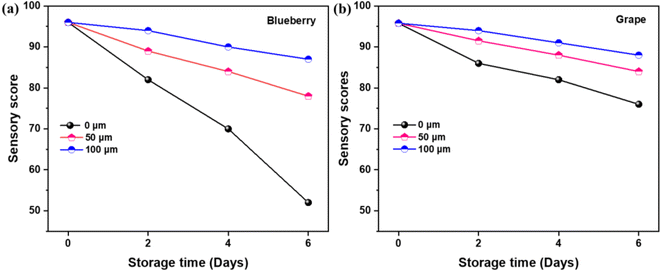 | ||
| Fig. 8 (a) Sensory scores of blueberry during storage in PVDC emulsion-coated WC packaging. (b) Sensory scores of grape during storage in PVDC emulsion-coated WC packaging. | ||
Conclusion
In this study, eco-friendly high-barrier coated white cardboard was successfully fabricated via a PVDC emulsion coating process. The coating selection and drying method of the coating procedure were mainly studied. Additionally, the effect of the coating amount on the apparent quality, mechanical properties, barrier properties, and fresh-keeping effect of the PVDC emulsion-coated WC was explored. The results revealed that the PVDC emulsion-coated WC enhanced the water resistance, oxygen barrier, and mechanical property compared with the WC substrate. Notably, the WVP value of the PVDC emulsion-coated WC (3.46 × 10−11 g m m−2 s−1 kPa−1) decreased 73.8% in comparison to that of the WC substrate, and the OP value of the PVDC emulsion-coated WC (14.8 cm3 m−2 day−1·Pa−1) decreased 61.9% relative to that of the WC substrate. The results showed that high-barrier PVDC emulsion-coated WC is extremely competitive to be chosen as an alternative to petroleum-derived plastics in fruit packaging materials. Particularly, the high-barrier PVDC emulsion-coated WC can alleviate the metabolic processes of blueberry and delay blueberry ripening, contributing to the extension of the shelf-life of blueberry. Overall, these findings demonstrated that environmentally friendly high-barrier coated WC shows great potential as a biodegradable and renewable fruit packaging material.Ethical approval
This article does not contain any studies with human participants or animals performed by any of the authors.Data availability
All the data and materials are accessible on request. Correspondence and requests for materials and data should be addressed to Zheng Cheng.Author contributions
Zheng Cheng: supervision, visualization, writing-review & editing. Jialin Li: writing-original draft, investigation, methodology. Miao Su: methodology, visualization. Naiyu Xiao: methodology, project administration, writing-review & editing. Le Zhong: conceptualization, data curation, writing-review & editing. Xueqin Zhang: resources, formal analysis. Meixian Liu: writing-original draft, validation. Qifeng Chen: methodology, formal analysis. Jinxian Zhou: validation, methodology.Conflicts of interest
The authors declare no conflict of interest.Acknowledgements
The research is supported by the National Natural Science Foundation of China (22108086), Fundamental Research Funds from the Zhongkai University of Agriculture and Engineering (KA24YY07116), Guangdong Basic and Applied Basic Research Foundation (2022A1515010323), Science and Technology Planning Project of Chaozhou Chao'an District “Development of Fully Degradable and Mouldproof Packaging for Paper-plastic Material” (CAIT[2022]116), and Science and Technology Planning Project of Guangzhou (2024A04J2301 and 2024E04J1231). We are grateful for these financial support.References
- W. Grzebieniarz, D. Biswas, S. Roy and E. Jamróz, Food Packag. Shelf Life, 2023, 35, 101033 CrossRef CAS.
- I. S. Bayer, D. Fragouli, A. Attanasio, B. Sorce, G. Bertoni, R. Brescia, R. Di Corato, T. Pellegrino, M. Kalyva, S. Sabella, P. P. Pompa, R. Cingolani and A. Athanassiou, ACS Appl. Mater. Interfaces, 2011, 3, 4024–4031 CrossRef CAS PubMed.
- M. Wu, R. Xu, C. Liu, B. Li and Z. Long, Sci. Rep., 2020, 10, 9936 CrossRef CAS PubMed.
- M. Xue, Z. Wen, R. Huang, X. Chai, W. Li, C. Chen and H. Chen, RSC Adv., 2022, 12, 22402–22409 RSC.
- S. Jeong and S. Yoo, Food Packag. Shelf Life, 2020, 25, 100530 CrossRef.
- Y. Xia, S. Wang, F. Meng, Z. Xu, Q. Fang, Z. Gu, C. Zhang, P. Li and F. Kong, Int. J. Biol. Macromol., 2024, 254, 127659 CrossRef CAS PubMed.
- Y. Liao, C. Wang, C. Huang, S. Y. Hussain Abdalkarim, L. Wang, Z. Chen and H.-Y. Yu, ACS Sustain. Chem. Eng., 2023, 11, 5908–5917 CrossRef CAS.
- Y. Shen, F. Seidi, M. Ahmad, Y. Liu, M. R. Saeb, A. Akbari and H. Xiao, J. Agric. Food Chem., 2023, 71, 16469–16487 CrossRef CAS PubMed.
- L. Yu, Appreciation, 2014, 168–188 Search PubMed.
- Y. Peng, J. Guo, Y. Gao, X. Li, M. Ni, X. Shen, Z. Chu, Z. Yang and Y. Hu, Food Hydrocolloids, 2024, 149, 109624 CrossRef CAS.
- M. N. Senghor, J. Bassama, E. B. Ly, F. Mora and N. Galaffu, Bioresour. Technol. Rep., 2024, 25, 101712 CrossRef CAS.
- M. Z. A. Mahmud, M. H. Mobarak and N. Hossain, Heliyon, 2024, 10, e24122 CrossRef CAS PubMed.
- S. Bhardwaj, N. K. Bhardwaj and Y. S. Negi, Cellulose, 2020, 27, 5337–5352 CrossRef CAS.
- R. Fengler and L. Gruber, Food Addit. Contam.: Part A, 2020, 37, 845–857 CrossRef CAS PubMed.
- K. R. H. K. Dokyoung, Materials, 2021, 14, 5775 CrossRef PubMed.
- W. Zhang, P. Lu, L. Qian and H. Xiao, Chem. Eng. J., 2014, 250, 431–436 CrossRef CAS.
- S. Tanpichai, Y. Srimarut, W. Woraprayote and Y. Malila, Int. J. Biol. Macromol., 2022, 213, 534–545 CrossRef CAS PubMed.
- M. Mujtaba, J. Lipponen, M. Ojanen, S. Puttonen and H. Vaittinen, Sci. Total Environ., 2022, 851, 158328 CrossRef CAS PubMed.
- H. Huang, L. Mao, W. Wang, Z. Li and C. Qin, Int. J. Biol. Macromol., 2023, 236, 123630 CrossRef CAS PubMed.
- H. J. Kim, L. T. Hao, G.-H. Lee, S. Choi, H. G. Chae, D. X. Oh, H. Kim and Y. Eom, Prog. Org. Coat., 2023, 182, 107672 CrossRef CAS.
- A. Apicella, P. Scarfato and L. Incarnato, Food Packag. Shelf Life, 2023, 37, 101096 CrossRef CAS.
- Z. Li, X. Wang, M. Wu, S. Yao, J. Guo, M. Chen, S. Xiong and L. Wang, Ind. Crops Prod., 2023, 204, 117322 CrossRef CAS.
- W. Fengjun, Print Today, 2019, 57–59, DOI:10.16004/j.cnki.pt.2019.07.014.
- S. Ubeda, M. Aznar, A. K. Rosenmai, A. M. Vinggaard and C. Nerín, Food Chem., 2020, 311, 125918 CrossRef CAS PubMed.
- A. Ali, S. Bairagi, S. A. Ganie and S. Ahmed, Int. J. Biol. Macromol., 2023, 252, 126534 CrossRef CAS PubMed.
- J. Ma, L. Chen, H. Wang, J. Zhang, W. Xiang and Y. Qu, Fine Chem., 2019, 36, 169–175 Search PubMed.
- I. Larraza, J. Vadillo, A. Santamaria-Echart, A. Tejado, M. Azpeitia, E. Vesga, A. Orue, A. Saralegi, A. Arbelaiz and A. Eceiza, Polym. Degrad. Stab., 2020, 173, 109084 CrossRef.
- W. Xu, L. Zhang, W. Liao, L. Liang, H. Huang and D. Lu, Plast. Sci. Technol., 2023, 51, 36–41 CAS.
- D. Pasquini, E. d. M. Teixeira, A. A. d. S. Curvelo, M. N. Belgacem and A. Dufresne, Compos. Sci. Technol., 2008, 68, 193–201 CrossRef CAS.
- E. Divsalar, H. Tajik, M. Moradi, M. Forough, M. Lotfi and B. Kuswandi, Int. J. Biol. Macromol., 2018, 109, 1311–1318 CrossRef CAS PubMed.
- Z. Cheng, J. Li, M. Su, N. Xiao, L. Zhong, X. Zhang, S. Chen, Q. Chen, W. Liang and M. Liu, ACS Appl. Polym. Mater., 2024, 6, 2877–2888 CrossRef CAS.
- C. Zhou, J. Bai, F. Zhang, R. Zhang, X. Zhang, K. Zhong and B. Yan, Carbohydr. Polym., 2023, 321, 121293 CrossRef CAS PubMed.
- H. Cheng, L. Chen, D. J. McClements, T. Yang, Z. Zhang, F. Ren, M. Miao, Y. Tian and Z. Jin, Trends Food Sci. Technol., 2021, 114, 70–82 CrossRef CAS.
- H. Lian, W. Wei and X. Yang, Storage Process, 2022, 22, 1–6 Search PubMed.
- J. M. Lagaron, R. Catalá and R. Gavara, Mater. Sci. Technol., 2013, 20, 1–7 CrossRef.
- X. Zhou, R. Cheng, B. Wang, J. Zeng, J. Xu, J. Li, L. Kang, Z. Cheng, W. Gao and K. Chen, Carbohydr. Polym., 2021, 251, 117117 CrossRef CAS PubMed.
- B. Yang, Y. Yang, Z. Huo and Y. Yu, Constr. Build. Mater., 2023, 367, 130292 CrossRef CAS.
- Z. Li, C. Tian, S. Yu, X. Lin, S. Liang and J. Wang, Thin Solid Films, 2022, 752, 139253 CrossRef CAS.
- W. Xiao and Q. Gu, Packag. Eng., 2013, 34, 28–30 Search PubMed.
- Y. Liu, S. Yi, D. E. Sameen, M. A. Hossen, J. Dai, S. Li, W. Qin and K. Lee, Innovative Food Sci. Emerging Technol., 2021, 74, 102808 CrossRef CAS.
Footnote |
| † Electronic supplementary information (ESI) available. See DOI: https://doi.org/10.1039/d4ra01308e |
| This journal is © The Royal Society of Chemistry 2024 |

